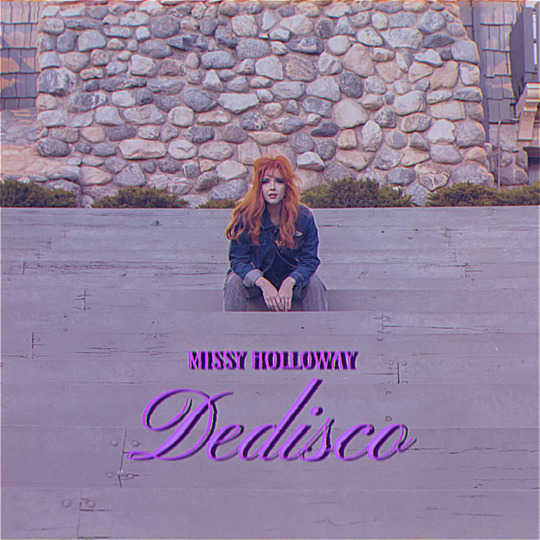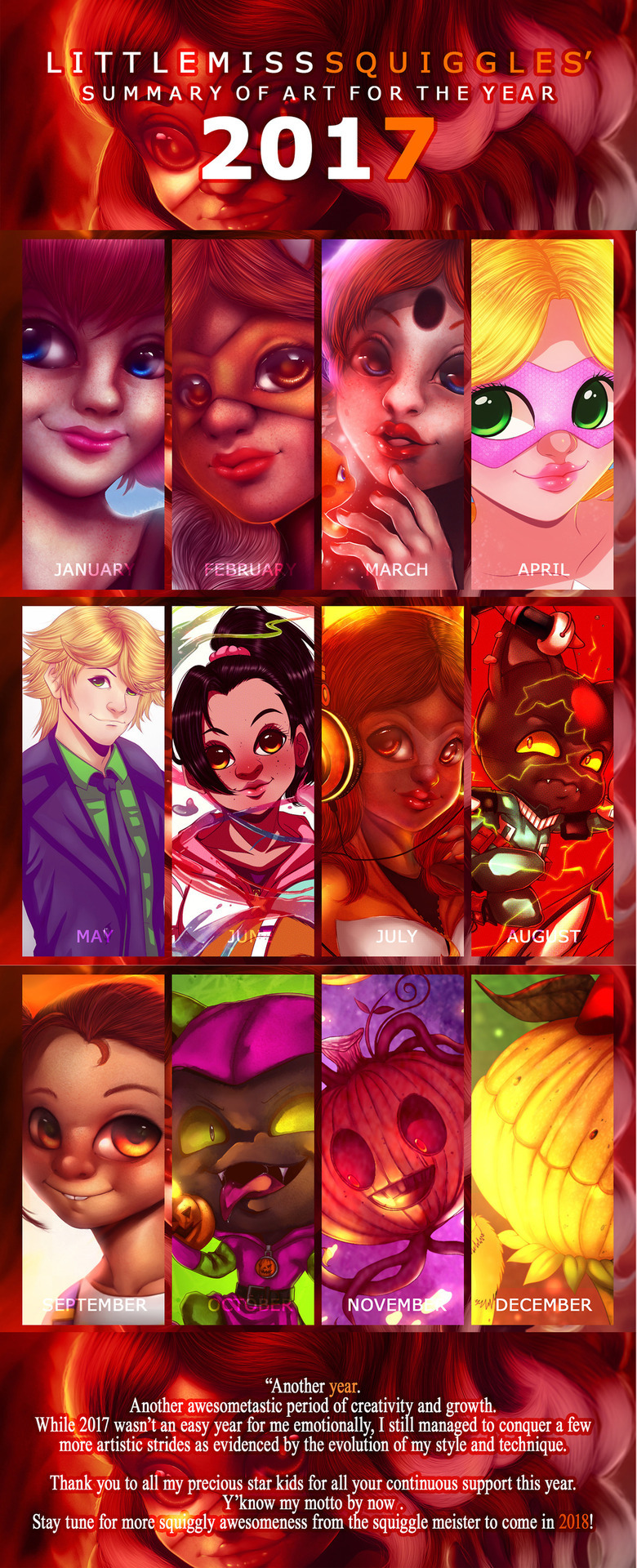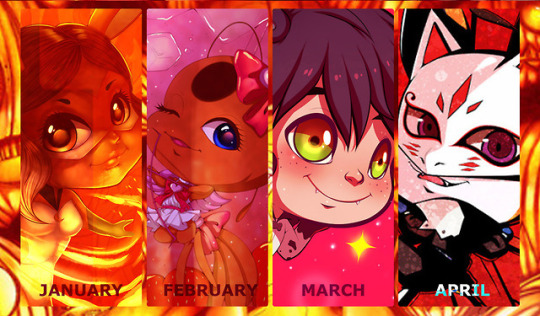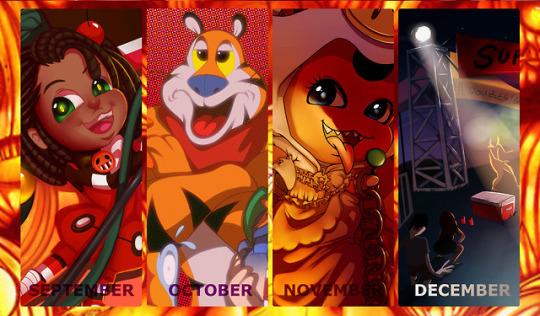#I may not be an artist but I sure can use canva at an intermediate level
Text
Miss Holloway album covers because I couldn't help myself




That last one is based on my personal headcanon that Miss Holloway wrote one last album before giving up her original persona, as a way to process. Dedisco not only contains the word 'disco', but it also literally means 'to un-learn,' or 'forget.'
I also had no idea what name she would've been going by in the 80's, so I settled on Missy because frankly I thought it would get me the least amount of backlash
#I may not be an artist but I sure can use canva at an intermediate level#hatchetfield#starkid#team starkid#miss holloway#kim whalen#the witch in the web#killer track#nightmare time#nightmare time 2#nmt#nmt2#hatchetverse#art#fanart#holloweane
287 notes
·
View notes
Photo









“LittleMissSquiggles’ Summary of Art 2018”
2018 was definitely a year of unexpected opportunities, is a way I’d like to put it. This was the year I earned my scholarship to study at Animschool. For those of you who don’t know, I actually studied animation back in 2010 and graduated with a Diploma in Digital Media Studies: Animation in 2012. I made due with the education I received because it was all I had available to me in my own country without having to go abroad (which I unfortunately can’t afford). Since then I’ve been searching for alternatives to continue my animation education specializing in 3D Art and Modelling because I’ve always been fascinated with 3D for years.
I was lucky to earn an opportunity to finally gain the education I’ve always wanted this year. Now I’ve successfully completed three terms of 3D Training in Modelling and Training and I’m gearing up for my remaining year. It’s been a challenge because there is a lot more to 3D than I anticipated but it has been a great learning experience being taught by fellow artists who’ve worked in the industry. My Rigging Teacher from last term worked on the Life of Pi for the former Rhythm and Hues and my Modelling Teacher is a modeller for Disney Animation Studios currently working on Frozen 2. It’s insane and I’m really glad I’m got this shot. Right now I’ve completed my Intro courses and now it’s time to go into Intermediate and Advance
Sorry if I’m talking more about school than my art here. But truth be told, I didn’t get to draw as much as I wanted to this year and part of it was due to school. The next part was due to my job.
For those of you who might not know either but I currently work as a Storyboard Artist/ Illustrator for an upcoming Trinbagonian animated web-series called Big Man Dan. I was roped into the project by a dear friend from animation school back in 2015. Last year I got the chance to board for the first pilot episode of the series and this year I was brought back to board again. We actually have a new animation out right now. A PSA Animated Short. I encourage you guys to please check it out on my behalf since as the storyboard artist on the project, I worked very hard under the direction with my the director and producer to help sculpt this PSA so that our talented animators could work their razzle dazzle magic and make it a reality.
I’ve only boarded on two projects for this studio I’m with but as a storyboarder, it’s always so amazing seeing the end results after the animators take the boards and bring them to life. It’s fantastic. So please check it out you guys. The more views we get, the more chances we can turn this into a full blown web-series with more episodes. You can find it here.
This has practically been my bread and butter since last year June and I’m happy that I was invited again on its next project. While still small and on its way, working on BMD has been a great experience for me and it’s taught me a lot about what it’s like to work on an animated series which makes me have a greater sense of appreciation for the people who create the series that I love and the media that I consume on a regular basis. Normally this is the part where my last piece of this year is also my first piece of last year. But basically I’m ending the year working on stuff for work and starting the New Year doing just that. My piece for December is actually a background art that I coloured (The Art Director did the initial sketch) for Big Man Dan: BigManTing! However I can’t share the full background art but it will be featured later in another #BigManTing PSA Animated Short coming soon. We have a total of 5. 1 is out now on Youtube and our website Story Play TV. I was the storyboard artist for all 5 PSAs. Can’t wait for you guys to see the rest of them coming soon in 2019.
Speaking of 2019. 2019 is the first creative year I’m going into with a legit blank canvas. While for this year and previous years I started off with an idea of the kind of projects I wanted to work on, for this coming year I’m not too sure. I know for the most part that there are ideas I’d like to work on and more squiggly things I’d love to draw. However for the most part, I actually want this year to be similar to my experience in 2013. A year of reflection, practice, change and improvement. Taking another thorough look at my art and style and going right back to that drawing board to focus on the things I still need to develop on.
There are a few important aspects to my art and style that I still need to flesh out. Still need to conquer and gain more confidence in and until that is achieved; I won’t be able to continue forward as the kind of artist I’m thriving to become. While I’ll admit my art has grown tremendously over the years to the point that, if you look back at my work from past summaries you wouldn’t believe that the work was done by the same person.
What I want 2019 to be is a year of creative rebirth. I pegged 2013 to be a sort of renaissance period for my art since I really found my stride in that year. I’m hoping that 2019 will be another renaissance for me again. I’ve had pretty much the same style for the past few years based on things that inspired me during that time. However my creative mind has changed a lot over the years to the point that the things I valued back then don’t hold the same meaning anymore; if that makes sense. I guess what I’m trying to say is that I think my art might be in for a change…or not. Who knows?
Whether that means a change in style or more pieces that focus on experimentation that help me break out of my comfort zone or maybe less pieces in general or perhaps it’s less focus on fanart and more on original ideas. Not sure. That’s why I said I’m going into the new creative year with a blank canvas.
A blank canvas that I get to once again fill with whatever I wish.
Not sure exactly how I’m going to achieve that yet short of just more practice and returning to my squiggly roots. All I know is that it’s going to involve a lot of self-reflection. I’m not sure how much of that is going to be achieved starting tomorrow but I’m looking forward to working as best as I can to get where I want and need to be artistically. That and…also successfully complete my 3D Modelling Training so that I can add 3D art to my calibre of squiggly skills too.
Until then, thank you super mega bunches of oats as always precious star kids for all the support you gave me this year. Thanks for liking my art and I hope you guys can still support and cheer me on for this New Year.
In keeping with tradition, I’m going to conclude my summary with my personal best piece for 2018. Though I didn’t draw as much as I wanted to this year, at the end of the day I’m still proud that I manage to complete this because it’s in relation to an original project I’m currently trying to work on. Can you say SPOOKZ?!

Thanks to Animschool I was finally able to flesh out the winning design for the main character of my SPOOKZ! Story; among other things. Not sure how much more progress I’ll get to make with my idea but for now, loved this piece and it was certainly worth being my best for this years!
Here’s to a new year of awesomeness precious star kids! All the best in your endeavours and see you in 2019 peeps! (ノ◕ヮ◕)ノ*:・゚✧ ✧゚・: *ヽ(◕ヮ◕ヽ)
♦ PREVIOUS ART SUMMARIES ♦
2013 | 2014 | 2015 | 2016 | 2017
♦ ART USED IN SUMMARY ♦
January | February | March | April | May | June | July | August | September | October | November | December
~LittleMissSquiggles (2018)
#art of littlemisssquiggles#art summary#art summary 2018#rwby#miraculous ladybug#artists on tumblr#onward to 2019
19 notes
·
View notes
Text
Verisimilitude
Reflection
Looking back over this paper, this is the kind of work that I could be truly proud of in philosophy. It really checked all of my boxes for what I liked in philosophical writing. It works through the problems in another philosopher's work, but builds on it as well; it advances a novel concept, in this case a new kind of verisimilitude than what we talk about in logic; and it has a sort of comical readability in forming intuitive examples.
Philosophy can be dry but really good papers in philosophy will find a weirdly intuitive, even gripping readability. When I was trying to write good philosophy I was always working on performing that aspect of philosophy in my writing. This was one of my last papers in philosophy and, like a lot of the writing I did at the very end of my philosophical career finally hit the mark I was aiming at for years in the discipline.
In the issue of the aesthetic values of copies and originals there may be differences between the aesthetic properties of originals and perfect copies which bear on an artwork’s overall value. Against Meiland, I believe it is faulty and less descriptive to give an account of copies where there is not some kind of difference about aesthetic properties compared to originals, but one which cannot be detected by whatever our aesthetic sense is. Carving out originality as a property the way that Meiland does is problematic. He does not recognize originality as an integral part of an artwork, and as being peculiar to original works. I will describe verisimilitude as an aesthetic property of copies distinct from originals. I should like to make it clear that I am not using verisimilitude in the traditional way--I mean verisimilitude in the sense of appearing authentic or as the genuine article. But I feel that ‘verisimilitude’ carries a weight which mere ‘likeness’ or ‘similarity’ may lack. In short, I agree with Meiland’s conclusions about aesthetic values being maintained but I argue that there are aesthetic properties which need further description in cases of copies. There are differences in aesthetic properties between originals and perfect copies. I will provide an account of how the difference can exist and be imperceptible, but it does not mean that the aesthetic value between originals and perfect copies is different. In certain contexts the difference between originals and copies will be only uncanny.
Meiland asks if copies have less aesthetic value than originals.[1] He finds the answer to be no, because perfect copies differ in no way from originals and therefore express the same work.[2] But copies do differ from originals in the way that they are not original, and originality is a property of artworks. Meiland gives some short shrift to originality despite identifying it. He explains that perfect copies express the originality of the original works, distinct from the creativity of the artist. So originality is determined to be this property of the work which is closely tied with the artists vision and even how we come to understand the importance of a work over time.[3] But for him it is a property which is equally expressible in copies. To give this account of originality is a mistake.
If originality is a property of the work it results from the formal characteristics that an artwork has. So originality is the result of putting e.g. these colors and shapes together on a canvas in this particular novel way which has not been done before. If the colors and shapes have not been put together this way before, then the work has the property of being “original” along with the other properties associated with aesthetic judgements like “elegant,” or “well composed,” and so forth.[4] We could even say of color field paintings that their form has not been produced before which makes them original despite their simplicity. I would not want to move past originality at this point to talk about the contexts artworks exist in when dealing with copies though because it strikes me that there is some intrinsic difference between the aesthetic properties of the original and that of the copy. It will only be in untangling originality from verisimilitude that we will have to look at external conditions.
I believe that a perfect copy does not express originality at all. How could it. A perfect copy cannot express originality lest it become an original of some sort, and copies do not strike me as instances of the original artwork. Instead copies have the property of being like an original in place of originality. In a copy there are formal characteristics in the same distribution as in the original, but the aesthetic properties are not all the same. Where we would point to a red shape in an original we could equally point to a red shape in a copy; where we would understand that shape to have originality in the original we could only understand it to have verisimilitude in the copy. The relation between copies and originals is not aesthetic in nature, but the copy has its formal characteristics in virtue of the original.[5] The aesthetic properties of a work are oneway dependent upon the point by point distribution of formal properties of the work; so where there is a difference in the distribution of formal properties of two works there is room for originality, where there is no difference in formal properties a work, viz. a copy, demonstrates verisimilitude. So verisimilitude supervenes on the originality properties of a work. This peculiar feature of copies is demonstrated by any sort of comparison between an original and a copy; the perfect copy is in no way original but it looks very like the original. Formal properties are distributed between original and exact copy the same way, but the aesthetic properties would differ because a copy does not have the property of being original.
I think that the details of Meiland’s examples and intermediate conclusions, thus, need to be changed. For instance we can make changes to a thought experiment where a copy of a work is made and the original is immediately destroyed. Meiland concludes that “the copy embodies the very same work of art as the original.”[6] He sees this as a reason that such a copy would be valued highly, which may be the case. But I think that Meiland misses the point that this whole situation, if discovered, would also be seen as something of a tragedy; we lost the original work. Further, although this strange copy would probably be valued very highly, it would not be seen as expressing originality. We could only say of that copy “thank heavens we have this copy from which we can make informed aesthetic judgement because it is very like the original in every way except originality.”
But there must be some kind of functional account to be given about how exact copies work so that they might dupe one into thinking they are the original. People, apparently, are adept aesthetic sensors, they are capable of aesthetic judgement and experience. The mechanism of this ability is not well understood, but it works. As we are taking in aesthetic properties such as elegance, drama, and, intuitively, originality or verisimilitude, we might say that these aesthetic properties innervate parts of our aesthetic sense. But like certain drugs do with receptors in our brain, verisimilitude binds to some originality receptor of the aesthetic sense. We experience originality when what we are getting is verisimilitude. But we can in some way be made aware of this feature in aesthetic experience much the same way one might stand back from his drug induced state. Much the way we can tell that we are restless as a result of the caffeine and not natural wakefulness we can tell that we are experiencing the aesthetic properties of an artwork but not the originality of it when we take in an exact copy. We could also be duped into making the wrong assumptions about a work by acknowledging verisimilitude as originality. If the above is the case then there is a difference in aesthetic properties without a difference in aesthetic judgement or even experience. If what we can glean about the work is the same in a copy as in the original, then it makes sense to say that experiencing the original and experiencing a copy have the same values. I can just as easily hold forth about Mona Lisa’s coy smile based on the copies I have seen as I could with the original work.
These characteristics of artworks and copies are seen in the real world. Considering the ways we could identify actual excellent copies validates that verisimilitude is this stand-in property for originality; in some cases we may not be able to just tell if a work is a copy or not. In actual copies we might be able to identify a small discrepancy where the copyist instanced something original. But in cases of forgery so good as to escape the charges of demonstrating any originality, there might be scientific evidence--carbon dating, fingerprints, pollen samples--which prove even such a good copy to be a fake. Surely these are not aesthetic properties and are not detectable by an audience. With advantages we might stand back with both copy and original and say "ah, I can see the differences now, the sheen on this one is different than on that one--clearly the result of synthetic paints--still if you stand back the copyist truly did capture the original, why from here the difference is almost uncanny, I've dropped my monocle!" Such information would, however, lead one to understanding that he was experiencing verisimilitude and not originality.
This account, where verisimilitude plays the same role as originality in the aesthetic sense and can be unraveled only in these specialized ways, might go a long way in explaining that experience of uncanniness about certain copies or forgeries or mechanical reproductions. But much like Meiland’s account, I think that we can protect the notion that there may be different significances and economic values applied to even exact copies but it is because they have this aesthetic property which we can determine but does not significantly impede our aesthetic valuation of artworks.
Endnotes
“Originals, Copies, and Aesthetic Value,” Meiland, Jack W. (Berkeley, 1983), (375).
Ibid, 382.
Ibid, 378-379.
I think that we can look at Frank Sibley’s “Aesthetic Concepts” as giving an account of properties a work has which nonetheless require aesthetic judgement to parse out (131). Formal properties, then aesthetic properties on top of them.
There is perhaps a hypothetical case where an artist replicates a work without knowing that he is doing so. I am not going to discuss such problems but I think that the connection between artist and artwork may hold a causal answer which Meiland would demure.
Meiland, 378.
0 notes